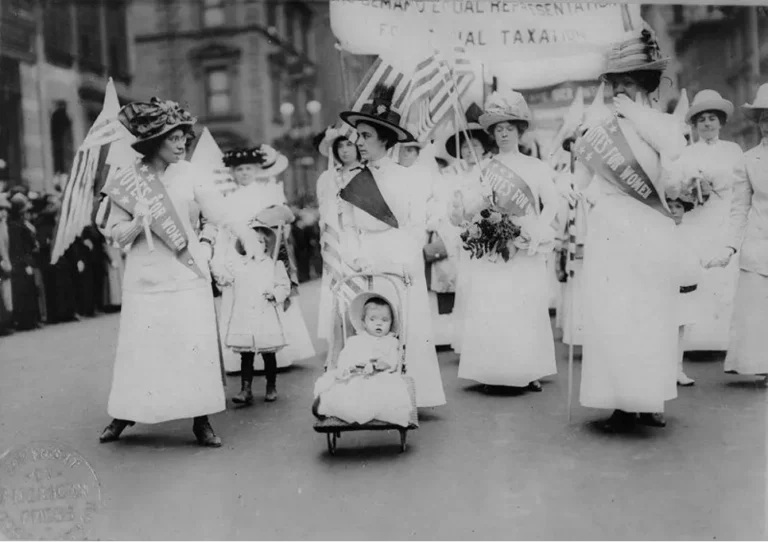What Was the Women’s Suffrage Movement?
The women’s suffrage movement was an important political and social movement in the mid-19th and early 20th centuries, mainly in Western countries.

The main aim of the movement was to guarantee women the right to vote and participate in politics on an equal footing with men. The movement was fueled by several factors, including demands for political equality, the expansion of civil rights movements and the emergence of more inclusive democratic ideals. Women began to organize themselves into groups and associations to promote their right to vote and to challenge gender inequalities in society. In many countries, the movement organized demonstrations, protests, hunger strikes and other forms of political activism. Women worked hard to gain recognition of their political rights, often in the face of strong resistance from institutions and mainstream society. Women’s suffrage was granted in different countries around the world at different times. The ideas behind these movements originated in France during the French Revolution, while the most important organized movements emerged in Britain in the second half of the 19th century.
The British Suffragette Movement
The British suffragette movement was born in 1869 and, after several years of activism, did not gain recognition until the 1920s. Determined to win the vote for women, the suffragettes openly defied the law and organized public protests. The movement was characterized by bold, non-violent actions such as mass demonstrations, hunger strikes and even acts of vandalism. Despite hostility and repression from the authorities, the suffragettes remained resolute and eventually achieved success with the Representation of the People Act of 1918, which granted the vote to women over the age of 30 in Britain. Ten years later, in July 1928, all women in Britain enjoyed the right to vote. In other European countries, women’s suffrage movements were inspired by the British one and had different results: in Germany, for example, women were granted the right to vote in 1919, while in France or Italy they had to wait until the end of the Second World War.
The Suffrage Movement In The US
The rest of the world followed a similar pattern, with countries such as New Zealand becoming the first in the world to enact women’s suffrage in 1893. In contrast, the debate in the United States was much longer. In 1869, Wyoming was the first state to partially extend the right to vote to women, while the rest of the country remained unchanged. In the United States, the women’s suffrage movement was linked to the struggle against slavery. Figures such as Lucretia Mott and Elizabeth Cady Stanton argued that both women and slaves deserved their rights. Stanton, along with another prominent figure, Susan B. Anthony, emerged as leaders of the movement as early as the 1850s.
When Wyoming joined the Union in 1890, it became the first state to enfranchise women in its constitution, sparking a national debate. Vigorous campaigns were then waged to persuade state legislatures to amend their constitutions to give women full suffrage in state affairs. Efforts were also made to give women the right to vote in presidential elections and, in some states, in local elections. Over the next 25 years, several states acceded to the movement’s demands and enfranchised their women; each of these states increased the number of women’s representatives in Congress. By 1918, women in 15 states had achieved equal suffrage with men.
How WWI Affected The Movement
The First World War, and the important role played in it by women in various capacities, brought down much of the opposition to women’s suffrage in the United States. Amendments to the federal constitution for women’s suffrage had been introduced in Congress in 1878 and 1914, but the 1878 amendment had been overwhelmingly defeated and the 1914 amendment had failed to win even a simple majority in the House and Senate (a two-thirds majority in Congress was required to send the amendment to the state legislatures for ratification). By 1918, however, both major political parties were committed to women’s suffrage and the amendment was passed by the required two-thirds majority in both the House of Representatives and the Senate in January 1918 and June 1919 respectively. Vigorous campaigns were then mounted to secure ratification of the amendment by two-thirds of the state legislatures, and on 18 August 1920 Tennessee became the 36th state to ratify the amendment. On 26 August, the Nineteenth Amendment was proclaimed by the Secretary of State as part of the United States Constitution. Women in the United States were formally recognized as equal to men.
Conclusion
The women’s suffrage movements that emerged in the early 20th century represented a major turning point in the struggle for gender equality. These movements were catalysts for unprecedented social and political change, as they emphasized the fundamental need to give women the right to vote and to participate actively in public life. Through the relentless struggle and determination of the suffragettes, women gradually won recognition of their civil and political rights, helping to rewrite the very fabric of democracy. The right to vote, won in several countries throughout the century, gave women not only a direct political voice, but also a new sense of dignity and empowerment. Beyond the vote, women’s suffrage movements raised crucial issues of access to education, employment and control over one’s personal affairs, prompting societies to rethink social and legal norms that limited women’s opportunities. In this way, the women’s suffrage movements of the 20th century laid the foundations for a wider civil rights revolution and progress towards a more equal and inclusive society.
